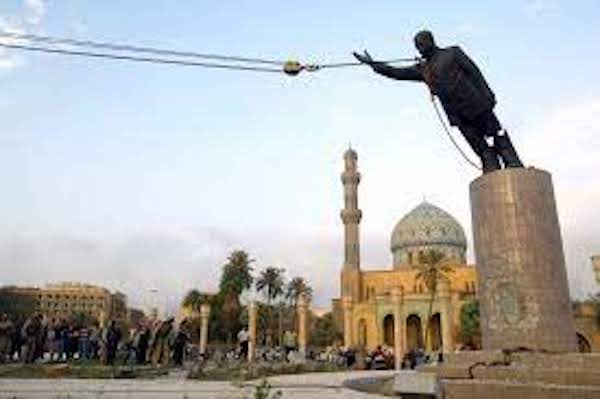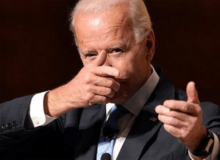In a March 2003 address from the Oval Office, President George W. Bush announced that the United States and its allies had embarked on a military campaign “to disarm Iraq, to free its people, and to defend the world from grave danger.” Like most Americans at the time, I supported the intrepid decision to end the barbaric regime of Saddam Hussein that made life miserable every day.
v
That campaign was a phenomenal success.
Saddam’s odious statue came down two decades ago this week in a moment of jubilation. And despite conventional wisdom that the Iraq War was solely about weapons of mass destruction (WMD), the decision to overthrow the malignant dictator was correct, honorable, and stands up to historical evaluation.
Strategic mistakes occurred in Iraq, as in all wars. After bravely removing Saddam from power, the coalition was slow to put Iraqis in charge of their government, disbanded the Iraqi army too rapidly, and didn’t anticipate the rogue insurgency led by Saddam’s loyalists. Because of that, the war lasted longer than we assumed and cost far too many lives.
d
But the invasion itself was absolutely justified.
j
The Butcher of Baghdad not only ruled Iraq with cruelty but posed a threat far beyond his borders. Society wants to ignore his evil doings, but the tyrant amassed a record of war crimes with few parallels in modern history. During his quarter-century in power, Saddam launched unprovoked wars against neighboring countries, murdered over 50,000 innocent Kurdish civilians in genocidal attacks, and engaged in torture.
f
Even the Washington Post declared Saddam “one of the contemporary world’s foremost sponsors of terrorism.”
He began two of the worst military conflicts of the latter 20th century — the Iran–Iraq war, which killed 1 million people in eight years, and the Gulf War, triggered by his unjust invasion of Kuwait. Not only did Saddam long pursue and develop WMD, but he also used them on the battlefield against Iran and for the mass murder of Kurds.
The U.S. and its allies attempted to contain Saddam via 16 UN Security Council resolutions. Iraq was subjected to economic sanctions, ordered to dismantle its stockpiles of WMD, and required to verify compliance with UN weapons inspectors.
But Saddam thwarted the weapons inspections and bypassed economic sanctions. In 1995, inspectors learned that Iraq’s WMD programs were far more extensive than they had realized. Three years later, bipartisan Washington consensus emerged that Saddam was too dangerous to remain in power. That autumn, Democrats and Republicans passed, and President Bill Clinton signed, the Iraq Liberation Act, making an explicit goal of U.S. policy “to support efforts to remove the regime headed by Saddam Hussein from power in Iraq.” (This was two years before Bush took office.)
l
When Saddam expelled weapons inspectors and refused to cooperate with the International Atomic Energy Agency, Clinton bombed Iraqi military sites; Saddam responded by firing at U.S. and British planes patrolling no-fly zones.
p
Democrats and populist Republicans who quickly castigated Bush and disingenuously still do today, then recognized that so long as Saddam remained in power, he posed an ominous threat. Even Joe Biden said in 1998 that “taking this son of a — taking Saddam down” was the only way to disarm Iraq of its WMD. It’s likely that a President Al Gore also would have invaded Iraq.
v
Remember, during the 9/11 attacks, there was an urgency to keep WMD away from Islamist terrorists. Given his history of using WMD, myriad connections with terrorist organizations, and disregard for the rule of law, the Bush administration decided Saddam could not remain in power. Congress voted by lopsided majorities to authorize military force against Iraq. In November 2002, the UN Security Council unanimously adopted a 17th resolution, offering Iraq “a final opportunity” to demonstrate that its biological and chemical weapons had been destroyed.
v
Intelligence agencies assessed that Saddam harbored WMD and refused to provide the Security Council with evidence proving he was disarmed.
v
Several months after Saddam was overthrown, the chief American weapons investigator in Iraq testified that Saddam’s covert weapons capacity remained intact. Other inspectors later concluded that Iraq always maintained the ability to produce deadly biological and chemical agents on short notice.
Pop culture and mendacious voices have convinced wrongheaded members of both parties — though thankfully not the majority of Republicans — that the Iraq War was solely predicated on WMD stockpiles. When they didn’t materialize, the media and Democrats speciously attacked Bush for having “lied” the country into war. Weapon stockpiles were never the chief reason for going to war. Bush’s primary case for regime change was the threat Saddam posed to the Middle East, and through collaboration with terrorists, to Americans.
f
The 43rd president was very patient, and you seldom hear his detractors grapple with the consequences of not invading. Democrats and ardent critics had access to the same intelligence briefings as the Bush administration.
The Iraq War, 20 Years Later. Iraq today is plagued by sectarian militias and endemic corruption, but it’s better off than it was under Saddam Hussein. https://t.co/AVMkbPL2zb via @commentary
— Eli Lake (@EliLake) February 15, 2023
We did not “lose” the war in Iraq; the current situation on the ground shows a fragile democracy, and metrics show life is better than before we invaded. This situation is especially telling compared to Afghanistan, where Biden’s catastrophic blunder made certain the U.S. actually lost a war, and the Taliban could claim victory.
g
The Iraq invasion was undertaken to remove one of the world’s bloodiest tyrants from power and prevent another horror, like 9/11, from killing Americans. That succeeded. Two decades later, despite revisionism and misinformation, these remain noble goals.
Ari Kaufman is a correspondent for several U.S. newspapers and magazines from Minnesota and Ohio to Tennessee and Virginia. He taught school and served as a military historian before beginning his journalism career. He is the author of three books and a frequent guest on radio programs and contributes to Israel National News and here at The Lid.






